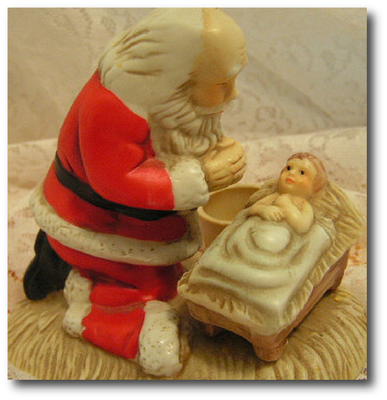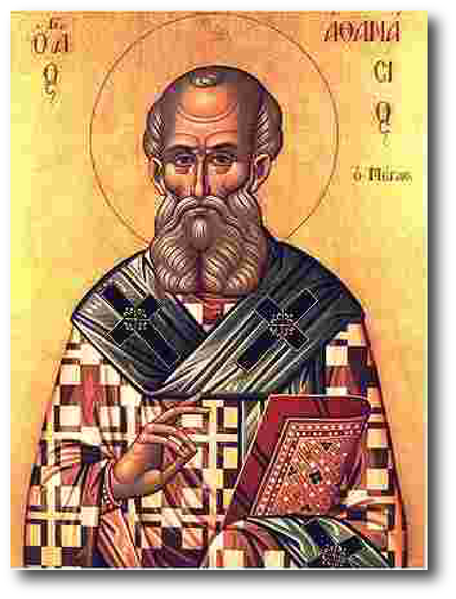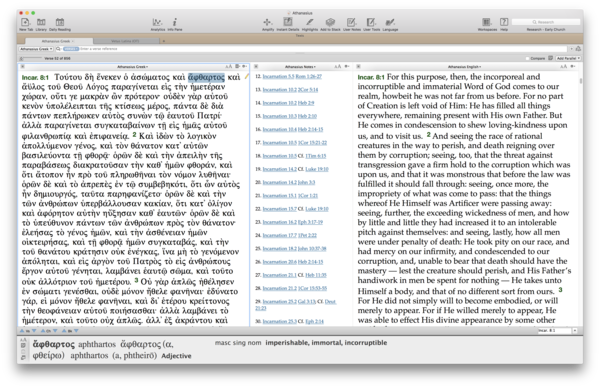Spoiler Alert: It has nothing to do with the big guy in the red suit.
“The things which they, as men, rule out as impossible, He plainly shows to be possible; that which they deride as unfitting, His goodness makes most fit; and things which these wiseacres laugh at as ‘human’ He by His inherent might declares divine. Thus by what seems His utter poverty and weakness on the cross He overturns the pomp and parade of idols, and quietly and hiddenly wins over the mockers and unbelievers to recognize Him as God.”
St. Athanasius, On the Incarnation, Accordance location: accord://read/Athanasius#3

I suppose in its day, these pins were a volley against the increasing commercialization of Christmas, a celebration that began as a true “holy day” in every sense of the word but eventually became distorted through the addition of a mythologized St. Nicholas, decorated trees, and flying reindeer. I eventually figured out that it was going to take much more than a lapel pin slogan to get the point across, and fully realized this on the day that I actually saw a custom-made, diamond studded (I kid you not) version of the “Jesus is the reason for the season” pin.
Most would agree that the Christmas popularized today is a far cry from the roots of the first advent and nativity of Jesus Christ. Don’t get me wrong—I don’t mind the Christmas trees and lights, and I suppose I’ve yet to turn down a Christmas gift offered to me. I realize that the kind of corrective-message pin that I described above meant little more than “Hey, let’s try to emphasize Jesus more than Santa Claus this year” regardless of how successful that message ever actually was. Setting aside cultural expressions of the Christmas holiday, I’d like to encourage the person who truly wants to embrace the idea that “Jesus is the reason for the season” (outward lapel pin or not) reflect not upon just the what or who of the nativity but also the why. And who better to help us do that than St. Athanasius of Alexandria.
St. Athanasius was born near the end of the third century and served as bishop of Alexandria–although often serving from exile–for 45 years. Most of Athanasius’ life and career (he probably would not have made such a distinction) was in reaction to the growing heretical movement known as Arianism.
Arius, an Alexandrian priest, “denied that the preincarnate Christ (the Logos) was co-equal and co-eternal with God the Father. Arius … argued that Christ was created by God out of nothing and was therefore a creature” (Pocket Dictionary of Church History, Accordance location: accord://read/Pocket_Church_History#74). As the teachings of Arius gained in popularity and influence, Athanasius took on the title Athanasius Contra Mundum (“Athanasius Against the World”).
Side note: For a thorough but concise overview of the life and works of St. Athanasius, I would encourage Accordance users to check out William Wright’s excellent entry on Athanasius in The Dictionary of Early Christian Biography from Hendrickson.
One of St. Athanasius’ most famous works in this regard is known as De Incarnatione (On the Incarnation). Our English word incarnation comes from the Latin, incarno, which means “to be made flesh.”
Interestingly, though, most historians of the early church agree that St. Athanasius wrote On the Incarnation before the rise of the Arian controversy. However, it was this work by Athanasius that created an apologetic and theological foundation from which to defend orthodox Christian teaching against the claims of Arius as the heretical movement gained momentum.
As might be expected, St. Athanasius pointed to the Fall in Genesis 3 as a cause for a growing corruption in humanity and in the world that God had prepared for his creation. In order for this to be corrected, the Incorruptible One had to enter into what had been corrupted. St. Athanasius writes,
“…it was our sorry case that caused the Word to come down, our transgression that called out His love for us, so that He made haste to help us and to appear among us. It is we who were the cause of His taking human form, and for our salvation that in His great love He was both born and manifested in a human body. For God had made man thus (that is, as an embodied spirit), and had willed that he should remain in incorruption. But men, having turned from the contemplation of God to evil of their own devising, had come inevitably under the law of death. Instead of remaining in the state in which God had created them, they were in process of becoming corrupted entirely, and death had them completely under its dominion. For the transgression of the commandment was making them turn back again according to their nature; and as they had at the beginning come into being out of non-existence, so were they now on the way to returning, through corruption, to non-existence again. The presence and love of the Word had called them into being; inevitably, therefore when they lost the knowledge of God, they lost existence with it; for it is God alone Who exists, evil is non-being, the negation and antithesis of good. By nature, of course, man is mortal, since he was made from nothing; but he bears also the Likeness of Him Who is, and if he preserves that Likeness through constant contemplation, then his nature is deprived of its power and he remains incorrupt.” (Accordance location: accord://read/Athanasius#21)
St. Athanasius explains further,
“For this purpose, then, the incorporeal and incorruptible and immaterial Word of God entered our world … This He did that He might turn again to incorruption men who had turned back to corruption, and make them alive through death by the appropriation of His body and by the grace of His resurrection. Thus He would make death to disappear from them as utterly as straw from fire.” (Accordance location: accord://read/Athanasius#43)
I would commend St. Athanasius’ On the Incarnation to Accordance users who want to gain a better understanding of why the First Advent took place. By today’s standards, Athanasius may not be an easy read. I would not recommend trying to rush through his thought process, but rather take him in small doses, allowing time for reflection.
Click/tap the image above for a larger view.
Fortunately, Accordance users have a few options when it comes to Athanasius. First, we have two English translations. I prefer the translation by Penelope Lawson, which is the translation from which I have quoted in the excerpts above, and available for the Accordance Library by itself (On the Incarnation of the Word by Athanasius). However, if you want to read Athanasius in the original Greek, a complete morphologically tagged edition is available that is designed to be read in parallel with the Schaff/Wace translation from the fourth volume of Nice and Post Nicene Fathers 2. This bundle includes a number of other works by Anathasius, all with both morphologically-tagged Greek, English translation, and notes (Works of Athanasius: Greek and English). And, speaking of the Schaff/Wace translation, if you read the text in the Nicene and Post-Nicene Fathers 2, you have the benefit of full descriptive headers for each section.
Although Arius may be no more, elements of Arianism are alive and well in our world today. Therefore, consider equipping yourself with the words of St. Athanasius, who wrote, “…wherever a man turns his gaze he sees the Godhead of the Word and is smitten with awe.”



